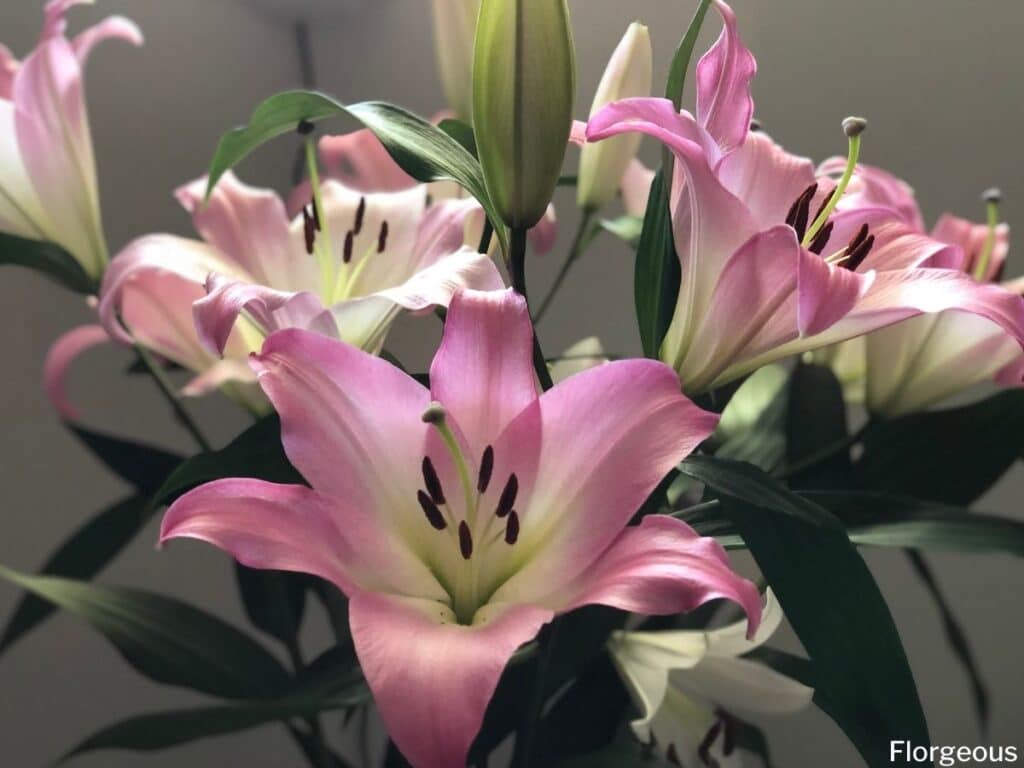Looking for some of the best large flowers to grow? You’re in the right place.
After all, you know what they say—variety is the spice of life. For gardens, the same concept rings true.
Planting a garden with flowers that are the same height, size, shape, and color can be visually dull. Mixing up any or all of these characteristics creates a visually appealing garden with depth and diversity that reflects your personality.
Using both large and small flowers has other benefits as well.
The University of Minnesota Extension program writes that pesky insects rely on “visual cues to find their target plants.” Creating an entire garden of the same flower can create an attractive buffet for destructive bugs.
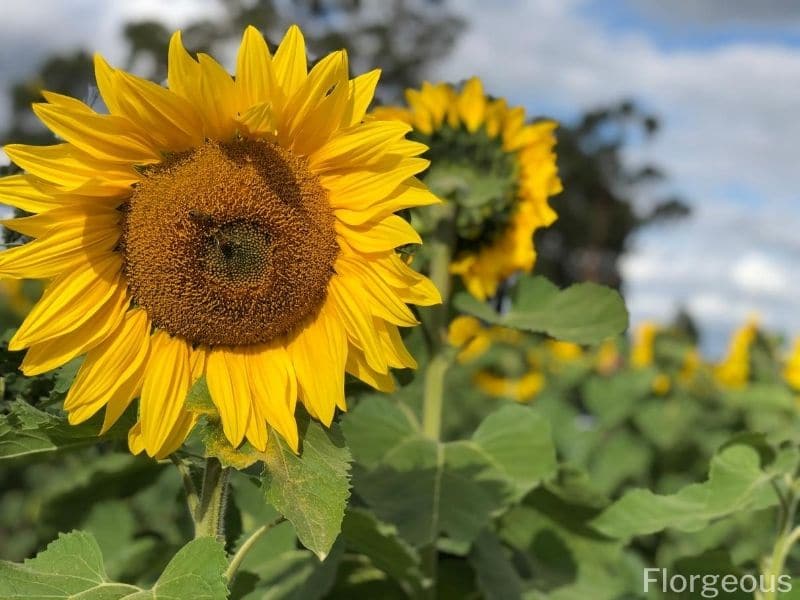
Planting a visually striking garden to your neighbors and pollinators may be visually distracting to destructive aphids and other beetles. Aphids and beetles rely on the shape of leaves and flower color to find their favorite food.
They can become confused when finding contrasting colors and sizes. Choosing, instead, to eat somewhere else.
Gardening is a great way to tap into your unique creativity. There are many ways to reveal your style, personality, and personal flair. Choosing huge flowers with different colors and blossom shapes, like roses and tulips, is a popular way to provide contrast and impact.
Changing up the flower size by combining large and small flowers in the same space can have an immediate impact visually. Instead of your eye seeing the whole garden at once, it needs to scan up and down to take in the entire picture.
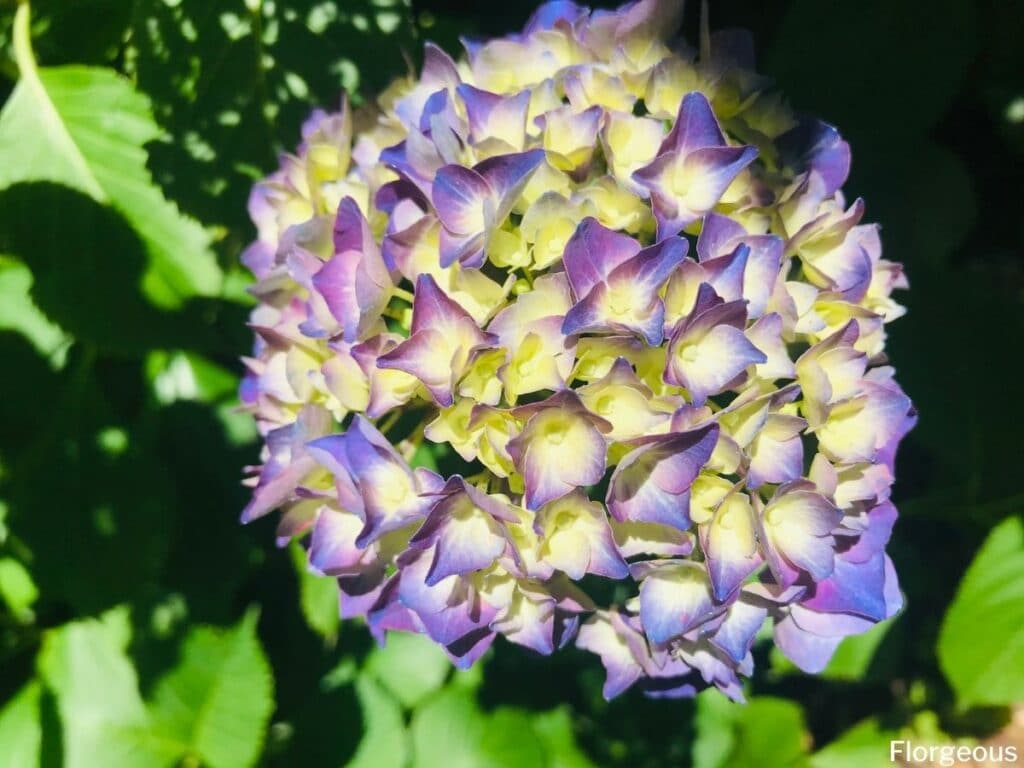
Scanning requires more time to process, which can deepen your emotional response. What you see and smell can impact how you feel. According to the Department of Psychology at Tufts University, both smell and sight can affect your mood and how relaxed you feel.
Gardens that are colorful, diverse, and smell pleasantly have the most significant impact on our emotions. Whether you are a novice gardener or someone that has planted a garden for years, this list can help you discover the magic of large plants.
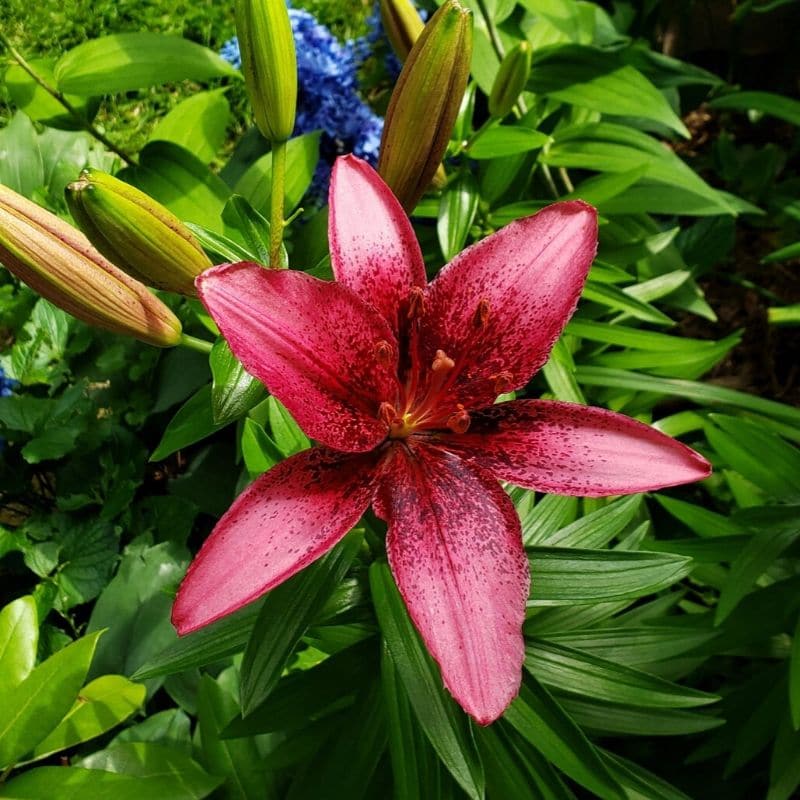
Tall Plants with Large Bloom Flowers
Deciding on which tall flowers to plant can be a daunting task. You need to consider which flowers will thrive in your climate and soil condition, which smaller plants you want to fill your garden with, and how much sun your garden receives.
The beautiful flowers listed below are a great place to start.
#1. Perennial Hibiscus
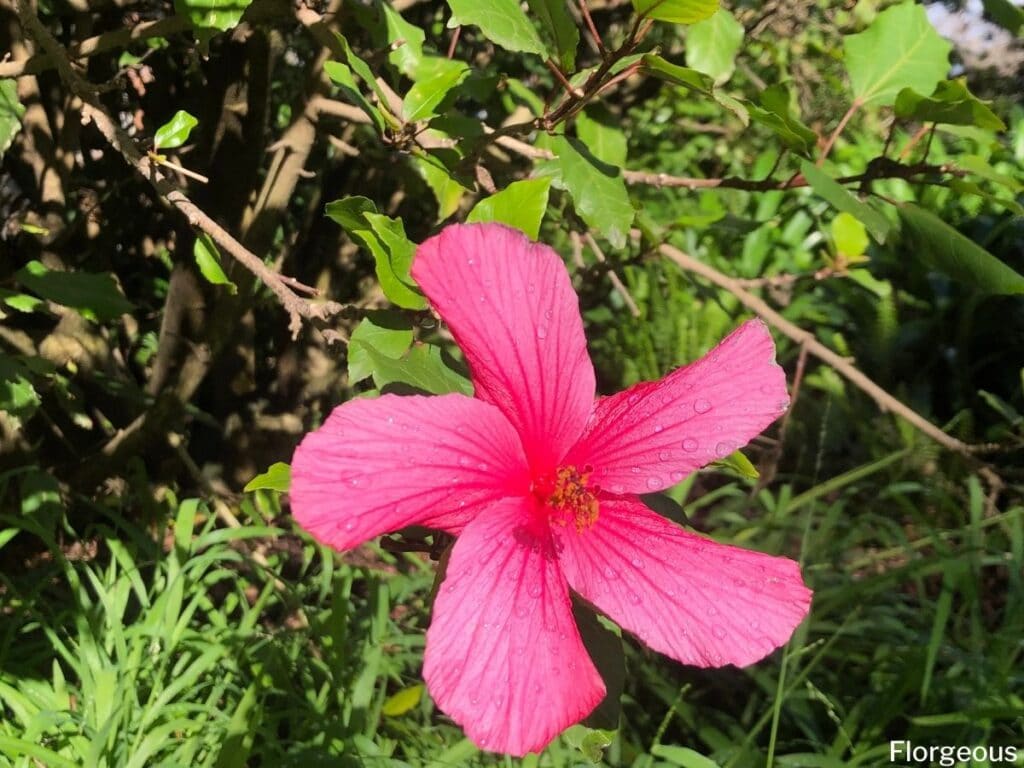
This hibiscus plant can grow to be seven feet tall. With red, pink, or white flowers that can span 12 inches, these hardy flowers bloom every spring. They may emerge late, but every season they produce more flowers than the year before.
The Perennial Hibiscus requires a lot of nutrients. They grow best in soil that is averagely moist but highly fertile. Full sunshine helps keep them looking their best.
#2. Oriental Lily
Oriental lilies don’t bloom until August. They are sure worth the wait! On average, these fragrant flowers grow between four and six feet tall. Their huge intricate blooms of red, pink, or white are sure to catch your eye.
To keep these lily flowers happy and healthy, you should plant oriental lilies in fertile, moist soil with access to the full sun. A professional gardening tip is to dig up the bulbs every few years to divide the clusters.
#3. Delphinium
These towering flowers provide some intense color to your outdoor landscape. Their blooming spikes can reach six feet high and are available in many colors. Blue is the most popular shade, but various hybrids include lavender, red, white, yellow, and pink.
Moist, rich soil is the ideal home for delphiniums. When it comes to the sun, these plants are picky. Morning sun and afternoon shade make a delphinium’s location just right.
If you want flowers that last into fall, you should plant these beauties. When the first blooms are dead, you can remove the flower stalk. Once all the dead stalks are removed, new buds will appear.
#4. Hollyhocks
When you picture a cottage garden, these may be the flowers you see. Hollyhock’s tall spires can grow up to eight feet tall. These colorful flowers add the perfect vertical dimension to your garden.
These mid-summer bloomers do well in full sun and moist soil with ample drainage. Bees, hummingbirds, and butterflies, such as painted ladies, are especially attracted to this classic, elegant plant.
#5. Giant Lily
These giant plants with trumpet-shaped flowers can reach heights of up to nine feet. Their creamy massive blooms are white with red-purple centers emit a strong but sweet fragrance.
Lily bulbs should live in moist, rich soil. A mixture of shade and sun is the perfect combination to keep these early summer bloomers happy and healthy.
#6. Canna
If you want your garden to feel like a tropical paradise, adding canna plants is the way to go. These low-maintenance plants can grow to be eight feet tall. With large leaves and flowers in red, yellow, orange, or pink, cannas can provide long-lasting color.
Like other tropical plants, cannas thrive in the sun. Boggy soil is ideal. Moist soil rich in nutrients also makes cannas feel right at home. To produce a more dramatic effect with your cannas, plant them along the border of your garden with other flowering plants.
#7. Sunflowers
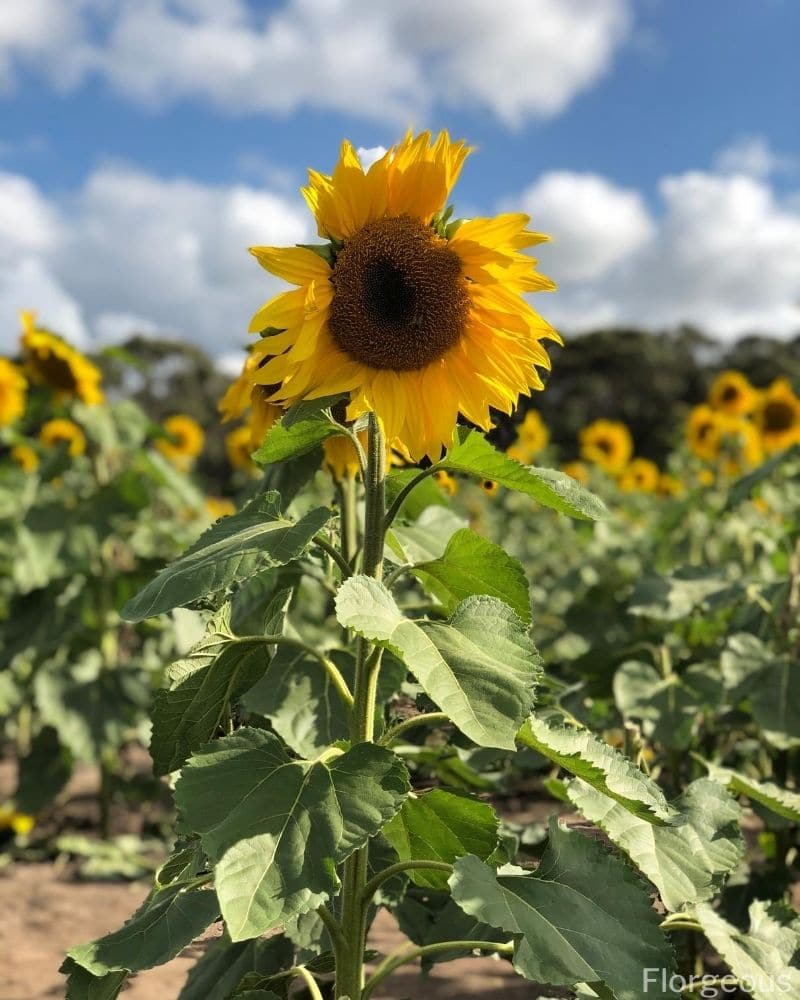
A list of tall flowers wouldn’t be complete without mentioning one of the most common flowers. Sunflowers are the perfect flowers for beginning gardeners because they are so easy to grow. There are so many varieties to choose from.
These sunny yellow flowers come in so many colors. The most popular is the standard yellow. If you’re feeling adventurous, choose a variety that comes in different colors, such as red or orange.
These sun-loving plants can grow in almost any type of soil. The better the ground, the more they will thrive.
When growing sunflowers, keep in mind that some can grow to be 12 feet tall. Be careful planting shorter flowers next to them. Plan your flower garden carefully, so you don’t block the sun from reaching the smaller plants.
Which Other Plant Has the Biggest Flowers?
While tall flowers are great, large-blooming plants are even better. If you have a vast space to fill, these flowers are a great option.
- Hydrangeas. These sturdy plants produce white blooms that can grow to nearly 12 inches.
- Bigleaf magnolias. These fragrant medium-sized trees produce white flowers that are between 8 and 12 inches. Their flowers aren’t the only big thing. Bigleaf magnolias can grow leaves that are three feet long.
- Summer Storm Hibiscus. While more petite than most hibiscus plants when it comes to height, these plants make up for it in their flower size. Their pink flowers grow between eight and ten inches long and are a fragrant beacon for hummingbirds.
- Dinnerplate Dahlias. These flowers with giant blooms come in a variety of species and colors. The average size of this flower’s bloom is between eight and ten inches.
- Supernova Angel’s Trumpet. These colorful plants grow trumpet-shaped flowers that can grow up to 18 inches long and 10 inches wide. Talk about jumbo!
- Tree Peony. These bush peonies are slow to mature, but the spectacle is a real treat when they do. These five-foot plants can produce 50 blooms, each measuring ten inches.
- Amaryllis. Each variety of this flower produces different-sized blooms. The Double Record Amaryllis has eight-inch flowers with red and white streaks.
- English rose. These large-cupped flowers with a heavy fragrance can produce six-inch blooms with 140 petals.
- Butterfly bush. As the name suggests, these flowers are filled with nectar which attracts butterflies throughout their blooming cycle. Each densely packed panicle can reach 18 inches in length and can have hundreds of florets.
- Fireworks Clematis. These stunning plants produce blooms that can reach eight inches across. As a vining plant, they can be used as an adornment for garden trellises.
The ten types of flowers included above have some of the largest blooms. It is not an exhaustive list, however. There are so many other flowers that also produce huge blooms to create beautiful pops of color.
Creating a beautiful garden is easy when you know where to start. The hard part is deciding which flowers to plant. Using various small flowers and large flowers can create a dynamic, contrasting, and eye-catching garden.
Why Adding Big Flowers to Your Yard?
Size does matter—when it comes to flowers, anyway.
You can choose to plant tall flowers, flowers with large blossoms, or flowers that have both. Each type has its own benefits.
Flowers with extra height can provide natural fencing or borders. These borders can create additional privacy. Extra-tall flowers also act as a contrast to smaller plants. When planted correctly, the size difference allows both flowers to be highlighted.
In addition, a study published in the Ecoscience journal suggests that tall plants are more attractive to pollinating insects and hummingbirds. Not only will the tall flowers receive more pollination, but so will the flowers planted around them.
Large bloom flowers provide a wow factor to your garden. The larger the flower, the more scent is produced. The increased smell attracts more pollinators, helping both the flowers and their neighbors.
Flowers, in general, have many benefits. Michigan State University Extension highlights some of these benefits. They explain that not only do flowers produce the oxygen we breathe, but gardening can also have health benefits.
Working in gardens and viewing nature can reduce stress, increase mental health, and provide moderate exercise. As a result, blood pressure can be lowered, your physical health and mental health can improve, and you are more relaxed. Michigan State University also suggests that gardening for 30 minutes can burn the same number of calories as a 30-minute walk.
With so many benefits, it is no surprise that gardening is a popular hobby.
Please be careful when designing your garden. Tall plants may shield their shorter neighbors from receiving the sunshine they need. Large blooms may block the sun from reaching their smaller-bloomed neighbors.
You want to create a unique garden. You also want a garden that allows all flowers to thrive, regardless of size.
Giant flowers are attractive to pollinating insects, hummingbirds, and butterflies. Tall plants with large blooms can help neighboring flowers thrive. Not only will the other flowers in the garden receive extra pollination, but pesky and destructive aphids and beetles can be disoriented and deterred by the differing colors and heights.
Tall flowers can provide natural privacy, blocking ugly fences or hiding your windows from prying eyes. They can also be used as natural borders, dividing your yard and the neighbors, or your yard and the street.
Flowers with large blooms can also act as natural barriers. Hydrangeas and other plants can serve as fences or borders. Vining plants, such as the fireworks clematis, can add color to the side of your house or patios by climbing trellises.
This is not an exhaustive list of large flowers. In fact, most of the flowers listed in this article fit into both categories. Most tall flowers produce large blossoms, and most large blooms are found on tall plants.
If you are in the beginning stages of your journey with gardening, use this list as a guidebook. It can help point you in the right direction. To fully understand the joys of gardening, you need to find your own preferences.
Find the flowers that fit your space. Find blossoms with colors you love. Find the plants that match your lifestyle. If you don’t have a lot of time to devote to gardening, choosing low-maintenance plants is the way to go.
Ask questions. Join a gardening community. Don’t be afraid to start over. The best part of gardening is being able to make it your own. Using this list can help you create a garden that is magical and diverse.
Large flowers are an excellent addition to any garden. Not only do they add brilliant color, but they also add a depth of height. This list is not complete. With so many different options of tall flowers, making your garden entirely unique for you is as easy as going to your local gardening store and buying seeds.
FAQs
What is the name of the big poofy flower?
The term “big poofy flower” is quite broad and could refer to several flowers, but one example is the Peony, known for its large, full, and poofy blooms.
Which is the largest beautiful flowers?
The title of the largest flower goes to the Rafflesia arnoldii, commonly known as the Rafflesia. It produces the largest individual flowers, with blooms that can reach up to three feet (about one meter) in diameter.

